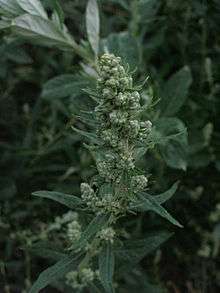Artemisia douglasiana
| Artemisia douglasiana | |
|---|---|
 | |
| Scientific classification | |
| Kingdom: | Plantae |
| (unranked): | Angiosperms |
| (unranked): | Eudicots |
| (unranked): | Asterids |
| Order: | Asterales |
| Family: | Asteraceae |
| Genus: | Artemisia |
| Species: | A. douglasiana |
| Binomial name | |
| Artemisia douglasiana Besser ex Besser | |
| Synonyms[1] | |
|
Artemisia heterophylla Besser | |
Artemisia douglasiana, commonly known as California mugwort, Douglas's sagewort or dream plant, is western North American species of aromatic herbs in the sunflower family.[2]
Distribution
The herbaceous perennial is native to the Western United States in California and areas of Idaho, Nevada, Oregon, and Washington; and in northwestern Baja California state of Mexico.[3][4][5][6]
The plant prefers direct sunlight and moist soils, but tolerates shady areas and dry soils. It occupies hardiness zones 6a to 10b and occurs at elevations ranging from 0–3080 meters.[7] A. douglasiana is often found in ditches and streambanks.
Description
Artemisia douglasiana is dicot, and a perennial forb. Its stems grow from a substantial colony of rhizomes which require a minimum soil depth of 16 cm and can grow in fine to coarse soils.[7] The stems grow erect and range in height from 0.5–2.5 metres (1.6–8.2 ft).[8]
Its grey-green leaves are evenly spaced, elliptical, and lobed at the tips.[8] The appearance of the 3-5 lobes at the tips of its leaves may range from being seemingly absent to being highly defined.
During its bloom period, which ranges from May to October, the plant features bell-shaped clusters of flowers containing 5-9 pistillate flowers and 6-25 disk flowers.[8]
Although A. douglasiana can reproduce from seed, it's primarily propagated from division and spreading of its underground rhizomes.[2] The extensive rhizomes help prevent erosion by stabilizing streambanks. A. douglasiana is susceptible to infection by Xylella fastidiosa which causes Pierce's disease.[7]
Uses
Its seeds are foraged by a variety of native birds and its leaves are used as nesting material by some native bees.[7][9]
Medicinal
Artemisia douglasiana was used by Native American tribes as a medicinal plant to relieve joint pain and headaches, and to treat abrasions and rashes (including poison ivy). It was also used to treat women's reproductive issues, including irregular menstruation and was occasionally used as an abortifacient.[10][11]
Ceremonial
This plant also had ceremonial and spiritual purposes for many tribes. It was commonly carried to ward off spirits of the dead and was smoked or drunk as a tea to induce vivid dreams.[12][13][14]
Phytochemistry
Its leaves have been shown to contain thujone and cineole.[12][15]
Cultivation
Artemisia douglasiana is cultivated as an ornamental plant by specialty native plant nurseries, for planting in wildlife gardens, natural landscaping design, and habitat restoration and erosion control projects.[9][16]
It is also planted by contemporary herbalists for both medicinal and spiritual uses.[17]
See also
- List of California native plants
- Natural history of the California chaparral and woodlands
References
- ↑ The Plant List Artemisia douglasiana Besser ex Besser
- 1 2 Flora of North America Vol. 19, 20 and 21 Page 524 Northwest mugwort, Douglas sagewort Artemisia douglasiana Besser in W. J. Hooker, Fl. Bor.-Amer. 1: 323. 1833.
- ↑ Biota of North America Program 2014 county distribution map
- ↑ Turner, B. L. 1996. The Comps of Mexico: A systematic account of the family Asteraceae, vol. 6. Tageteae and Athemideae. Phytologia Memoirs 10: i–ii, 1–22, 43–93.
- ↑ CalFlora taxon report, University of California: Artemisia douglasiana (California Mugwort, Douglas' sagewort, Mugwort)
- ↑ San Francisco State University, Biogeography of Mugwort by Laurel Poeton
- 1 2 3 4 "A. douglasiana: Plant Characteristics and Associations". Calflora. Retrieved 20 August 2014.
- 1 2 3 "A. douglasiana". Jepson eFlora. UC Berkeley. 2013. Retrieved 20 August 2014.
- 1 2 NPIN−Lady Bird Johnson Wildflower Center: Artemisia douglasiana (Douglas mugwort, Douglas' sagewort)
- ↑ University of Michigan at Dearborn: Native American Ethnobotany of Artemisia douglasiana
- ↑ UC Irvine: Local natural history & ethnobotany of Artemisia douglasiana (California Mugwort)
- 1 2 "Information About California Mugwort". Indigenous Knowledge Project.
- ↑ "Native American Uses of California Plants: Ethnobotany" (PDF). University of California, Santa Cruz Arboretum.
- ↑ Hunn, Eugene S. (1990). Nch'i-Wana, "The Big River": Mid-Columbia Indians and Their Land. University of Washington Press. p. 352. ISBN 0-295-97119-3.
- ↑ Somaweera, H; Lai, G. C.; Blackeye, R; Littlejohn, B; Kirksey, J; Aguirre, R. M.; Lapena, V; Pasqua, A; Hintz, M. M. (2013). "Ethanolic Extracts of California Mugwort (Artemisia douglasiana Besser) Are Cytotoxic against Normal and Cancerous Human Cells". Journal of Herbal Medicine. 3 (2): 47–51. PMC 3780460
 . PMID 24073389. doi:10.1016/j.hermed.2013.01.001.
. PMID 24073389. doi:10.1016/j.hermed.2013.01.001. - ↑ Las Pilitas Horticulture Database: Artemisia douglasiana (California mugwort)
- ↑ Alternative Nature’s Online Herbal: Mugwort
External links
- United States Department of Agriculture Plants Profile: Artemisia douglasiana (California mugwort)
- Jepson Manual Treatment — 'Artemisia douglasiana
- University of Michigan-Dearborn: Ethnobotany of California mugwort
- Lady Bird Johnson Wildflower Center, University of Texas
- Oregon Flora Image Project
| Wikimedia Commons has media related to Artemisia douglasiana. |